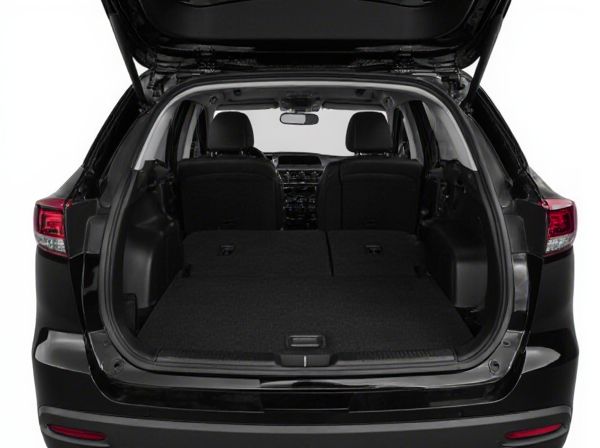
Photo illustration: Pass-Through vs Fixed Rear Seat
A pass-through rear seat provides convenient access to the trunk, allowing you to transport long items without compromising passenger space. Fixed rear seats, on the other hand, offer a more stable seating area but limit cargo flexibility. Choosing between the two depends on whether you prioritize versatility or consistent seating comfort.
Table of Comparison
| Feature | Pass-Through Rear Seat | Fixed Rear Seat |
|---|---|---|
| Functionality | Partial fold-down for long items like skis | Rear seat remains upright, no fold-down option |
| Cargo Flexibility | Allows extension of trunk space into cabin | Limited to trunk space only |
| Passenger Comfort | Maintains seating for rear passengers with partial opening | Full seating integrity, no intrusion into passenger space |
| Use Case | Ideal for transporting long, narrow items | Best for maximizing passenger seating |
| Complexity | Requires additional hinges and latching mechanisms | Simple fixed seat design |
Introduction to Rear Seat Configurations
Pass-through and fixed rear seat configurations serve distinct purposes in vehicle design, influencing passenger comfort and cargo versatility. Pass-through rear seats feature a foldable center section that allows longer items, such as skis or lumber, to extend into the cabin without fully folding the rear seats, enhancing practicality. Fixed rear seats, on the other hand, prioritize structural rigidity and passenger comfort but limit cargo flexibility by remaining immovable.
What is a Pass-Through Rear Seat?
A pass-through rear seat features a central panel that folds down independently, allowing access to the trunk without lowering the entire rear seat. This design is ideal for transporting long items like skis or lumber while maintaining passenger seating on either side. Compared to fixed rear seats, pass-throughs offer enhanced cargo versatility and convenience for mixed passenger and freight needs.
Understanding Fixed Rear Seats
Fixed rear seats offer enhanced structural rigidity and improved safety by eliminating moving parts that can weaken the vehicle's frame. These seats provide a stable seating arrangement designed to maximize passenger comfort and support, especially in vehicles prioritizing rear passenger space over cargo flexibility. Understanding the benefits of fixed rear seats helps in choosing a vehicle that balances passenger safety with seating durability.
Key Benefits of Pass-Through Rear Seats
Pass-through rear seats offer enhanced cargo flexibility by allowing long items such as skis or lumber to extend from the trunk into the cabin without folding down the entire seat. This design maintains passenger comfort and seating capacity while providing easy access to larger storage space. Key benefits include improved versatility for transporting bulky items and seamless integration with existing rear seat configurations.
Advantages of Fixed Rear Seats
Fixed rear seats offer enhanced structural stability, improving vehicle safety by providing a more rigid frame that better absorbs impact during collisions. These seats maximize usable cargo space by eliminating gaps or movable joints, allowing for a consistent flat load floor ideal for transporting larger items. Maintenance and repair costs tend to be lower with fixed rear seats due to their simpler design and fewer mechanical components compared to pass-through options.
Cargo Flexibility: Pass-Through vs Fixed
Pass-through rear seats offer enhanced cargo flexibility by allowing long items like skis or lumber to extend through the center without folding the entire seat down. Fixed rear seats limit cargo options because the seatbacks remain upright, restricting the ability to transport longer or bulkier items. Vehicles with pass-through designs maximize space utility for varied cargo needs while maintaining passenger seating.
Impact on Passenger Comfort and Legroom
Pass-through rear seats offer enhanced flexibility by allowing longer items to extend from the trunk into the cabin, which can reduce available legroom for rear passengers and slightly impact comfort on longer trips. Fixed rear seats maximize dedicated passenger space, ensuring consistent legroom and improved seating comfort, especially for taller passengers or those requiring more leg space. Choosing between pass-through and fixed rear seats directly affects rear passenger comfort and the vehicle's overall cargo-passenger balance.
Security Considerations for Both Options
Pass-through rear seats offer secure storage by allowing long items like skis or tools to extend into the trunk without compromising passenger safety or cabin security. Fixed rear seats provide enhanced structural integrity and prevent unauthorized access to the trunk, reducing theft risk. Both options require vehicle-specific locking mechanisms and reinforced seat designs to maximize occupant protection and cargo security.
Ideal Use Cases for Each Seat Type
Pass-through rear seats are ideal for drivers who frequently transport long items such as skis or lumber, allowing these objects to extend from the trunk into the cabin without sacrificing passenger space. Fixed rear seats suit vehicles primarily used for carrying multiple passengers, providing enhanced structural stability and often more comfortable seating configurations. Families and carpoolers benefit from fixed seats, while outdoor enthusiasts and tradespeople find pass-through seats more practical for their gear and equipment needs.
How to Choose the Right Rear Seat for Your Needs
Choosing the right rear seat depends on your lifestyle and vehicle usage; a pass-through rear seat offers flexibility for transporting long items like skis or lumber while still accommodating passengers. Fixed rear seats provide enhanced stability and durability, ideal for families prioritizing consistent passenger comfort without frequent cargo needs. Evaluate your daily transport requirements, balancing cargo versatility against passenger space to make the most functional and efficient choice.
 caratoz.com
caratoz.com